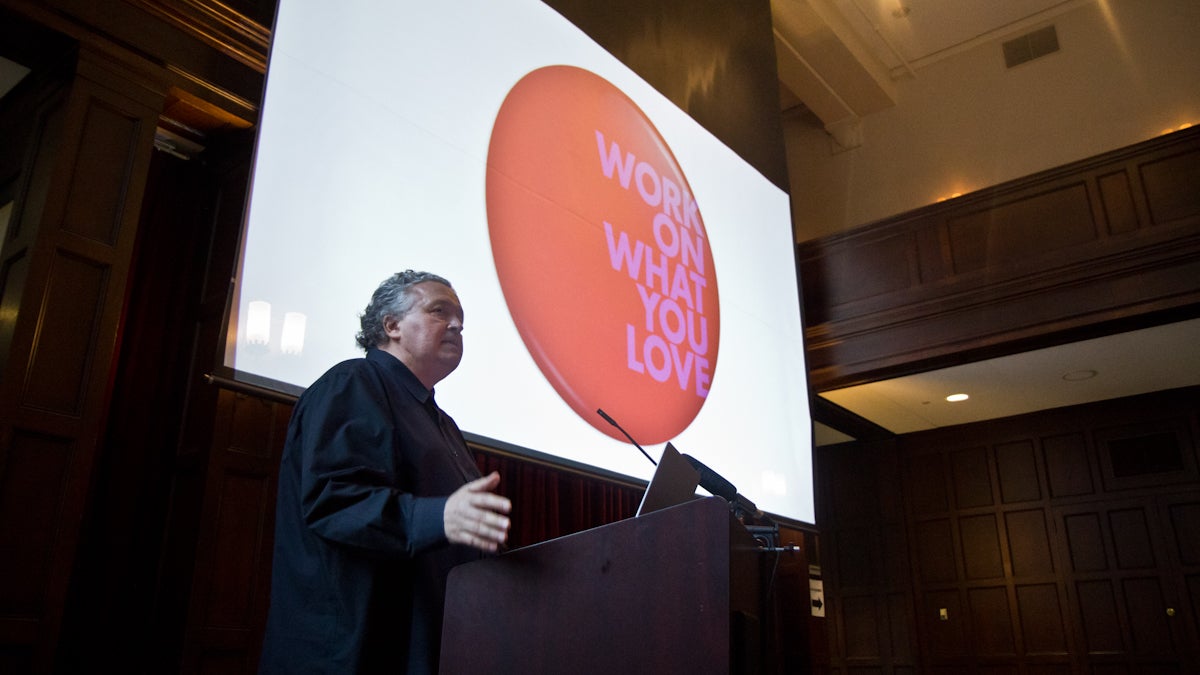Design technique applied to social problems
Listen
Designer Bruce Mau speaks to Penn design students about important principles he’s identified over his career. (Kimberly Paynter/WHYY)
How do you solve a problem like Philadelphia?
First, ask the right question.
“No client articulates clearly what the problem is,” said designer Bruce Mau. “They often express it as a solution. They say ‘I need this.’ Is that what we really need? What is that solution solving for? Let’s talk about the question.”
Mau’s design methodology is the subject of an exhibition “Work On What You Love,” now on view at the Philadelphia Museum of Art. He works in a field called geodesign, applying design principles to social, political, and urban problems.
As part of the exhibition, Mau — who is based in Chicago — is leading three workshops with Philadelphia organizations, guiding them through his problem-solving method.
The University of Pennsylvania’s School of Design is one organization that took him up his offer. About 60 architects, designers, and urban planners – mostly students – spent an evening on the question: How can we use design to make Philadelphia a more equitable city?
At the outset, Mau told them not to expect a solution.
“We don’t have a magic bullet that is going to create an equitable Philadelphia that no one in Philadelphia has ever thought of. That’s not why we’re here,” said Mau from a podium inside Penn’s Houston Hall. “We’re not going to solve problems that the people of Philadelphia can’t possibly solve. It’s not that.”
The designers were there to engage in the Mau method, 24 Hours to Massive Change, with which he says he can design anything from campaign strategies to furniture. The process involves a series of bumper sticker-ready aphorisms like, “We are not separate from or above nature,” “Think like you are lost in a forest,” “Compete with beauty.”
One of the participants, Annette Fierro, is an associate professor of architecture at Penn. The main challenge to equity in Philadelphia, she said, is a failing school system.
“I’m an architecture professor. I’ve studied the design of schools. I can talk about the space and light and color and acoustics beneficial to a learning environment,” said Fierro. “But how can you redesign a symbol? How can you redesign faith in a system? How do we engage imagination that cuts through bureaucracy?”
Another participant was Karen M’Closkey, a professor of landscape architecture at Penn who advocated for sidewalk landscaping. “If we collectively decided our streets are our most important environmental and social commons, they would look radically different,” she said.
The planners split into small groups and came up with ideas, like transforming prisons as vocational learning centers; creating a mandatory mentorship program pairing every college student with a younger student in the city’s school system; and dividing the city into neighborhood micro-economies to encourage hyper-local entrepreneurship.
The groups had only an hour to collaboratively brainstorm a concept and prepare a presentation; some ideas were more coherent than others.
The end result was not a list of initiatives to be sent to the mayor. The Massive Change process fostered dialogue among designers, challenging them to think differently about creating equity in a city.
“It has to do with things like faith and attachment, more emotional qualities,” said Randall Mason, director of PennPraxis, the School of Design’s public practice arm. The works was coordinated by his office.
“We didn’t get to politics and the distribution of resources and the difficulties with the school system. We talked about bigger, more ephemeral ideas,” he said.
Mason’s group spent most of its hour envisioning Philadelphia as a place designed to foster “everyday patterns of happiness.”
Mau believes none of this is beyond the scope of possibility. “It’s not pie in the sky. We’re pie on the table,” he said.
There is one more workshop scheduled to go through Bruce Mau’s Massive Change process. It will be held on March 12th at the Latino cultural organization Taller Puertorriqueno, to brainstorm how it can use art as a catalyst for growth.
WHYY is your source for fact-based, in-depth journalism and information. As a nonprofit organization, we rely on financial support from readers like you. Please give today.





